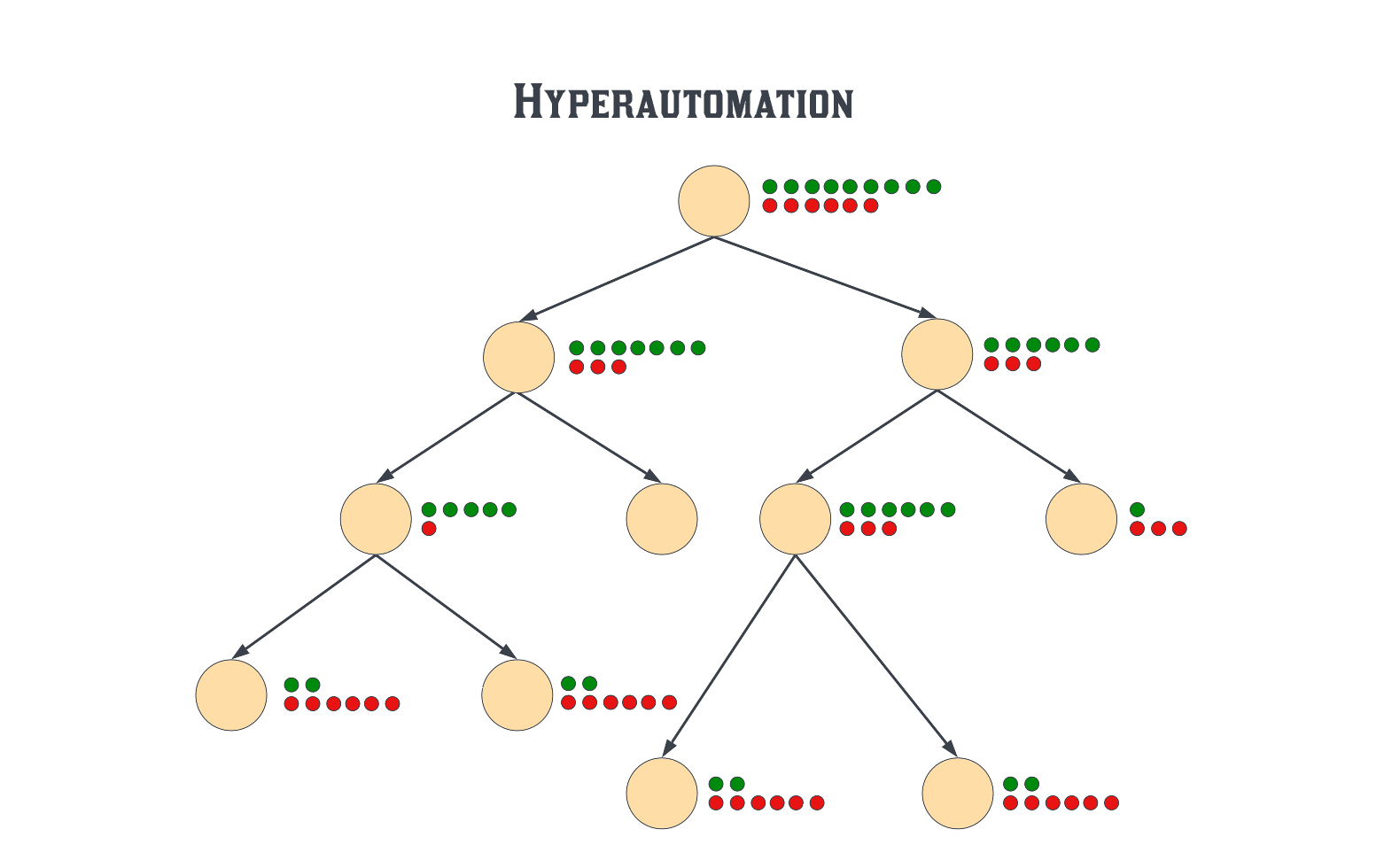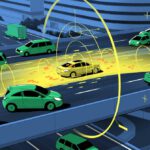
Introduction
Business automation and digital transformation have become key to securing the future of businesses around the world. One of the more recent extensions of the concept of transformation is hyperautomation.
Table of contents
What is Hyperautomation?
Hyperautomation technology takes automation opportunities one step further. The term was coined by industry analytics and consultancy firm Gartner. Gartner defines hyperautomation as a “business-driven, disciplined approach that organizations use to rapidly identify, vet, and automate as many business and IT processes as possible.”
The concept combines automation tools and technologies with emerging technologies. The goal is to accelerate the digital transformation of businesses and to improve the application of current automation technologies. It would be easy but too simplistic to dismiss hyperautomation as just another buzzword. However, the necessity to name a relatively this concept not only reflects a new approach by analysts. It also demonstrates the desire of businesses to implement higher, more efficient levels of intelligent automation than they currently can.
Whilst the concept is relatively new, it has been around for long enough to demonstrate that it resonates with industry representatives. Looking at records of Google searches shows that interest in hyperautomation has been growing since late 2019. Since then, search numbers have increased steadily, including during the coronavirus pandemic.
Experts believe that hyperautomation has significance beyond being a buzzword because of its potential to impact the future of companies.
Components of Hyperautomation
Hyperautomation is a framework that combines several emerging and advanced technologies. The aim is for this multitude of automation technologies to complement one another in a manner that allows companies to eventually automate the entire process of automation.
Leading technologies coming together as agents of hyperautomation include:
Robotic process automation (RPA)
Process mining
Optical character recognition
Digital twins
Natural language processing
Additional artificial intelligence (AI) and machine learning technologies
Whilst no single automation tool is superior to others, RPA and process mining are two of the core technologies utilized by hyperautomation initiatives. For that reason, we will elaborate on both in greater depth, as well as cover the remaining technologies.
Also Read: How Can RPA Help In Healthcare?
Robotic Process Automation (RPA)
RPA is also known as software automation. As a productivity tool, it helps users configure bots so they can reproduce specific tasks within a business process or an IT process. Current applications include passing data between apps, triggering transactions, claims processing, and other interactions between processes.
In RPA applications, robots take over tasks that were previously associated with and reserved for humans. Most of those complex tasks require human capabilities like learning and understanding to start with. However, once the algorithm governing the robot has been trained sufficiently, many robots can complete repetitive tasks in real time, faster and more consistently than humans.
Automation robots are digital workers that are capable of running 24/7, allowing them to process far more data in less time. They do not become distracted or need to take a break, making them the perfect choice for repetitive tasks.
Process Mining
Process mining is another core technology that supports hyperautomation. It describes a data-driven way of validating and improving workflows. The term combines the benefits of process analytics and data mining to enhance intelligent business process management at various levels.
No matter how well-designed business processes are, most fall victim to bottlenecks that designers did not foresee. In some cases, humans can be those bottlenecks. Process mining utilizes data to analyze existing complex processes. These advanced analytics give your company’s leadership teams objective information on which to base their decisions.
Because it is based on data, process mining minimizes the risk associated with making big decisions about the future of the business. As part of increasingly AI-driven decision making, process mining can help select areas of the business that could benefit most from task automation.
Optical Character Recognition
Optical character recognition (OCR) extracts data from a variety of documents and changes the information into machine-readable characters. This digital technology comes into its own when it is merged with AI and RPA. Together, these technologies remove the need for humans to work on data extraction or capture from documents. OCR can limit the amount of repetitive work humans have to undertake.
Digital Twins
Digital twins are virtual copies of processes, products, services, or entire organizations. Digital twins allow organizations to visualize key performance indicators, processes, and business functions to better understand what influences results. These copies allow leadership teams to simulate transformations and accurately predict the effect of organizational changes.
Natural Language Processing
Natural language processing (NLP) allows machines to understand the content of so-called unstructured data inputs like emails, videos, or social media posts. NLP technology can analyze sentiments expressed in communication, translate content, and classify texts into various categories. This is one of the technologies capable of automating tasks previously reserved for knowledge workers.
Additional Artificial Intelligence (AI) and Machine Learning Technologies
Artificial intelligence and machine learning (ML) have become integral parts of our lives by now. Whilst AI mimics human intelligence, machine learning enables AI through learning algorithms used by machines such as computers. ML allows algorithms to continuously learn without constant human input or explicit programming. Both technologies have become integral to intelligent business management software.
How Does Hyperautomation Work?
Hyperautomation combines several technologies to improve digital process automation. The hyperautomation journey starts by identifying which business processes lend themselves to automation, followed by selecting the right tools. Hyperautomation uses existing automation but aims to extend its capabilities. In most cases, adding various applications of AI and machine learning.
To be successful, hyperautomation requires a wider, systems-based approach to intelligent process automation. Done right, improving automation increases productivity, allowing businesses to benefit from previously inaccessible levels of unmatched efficiency. It is rare for two hyperautomation processes to ever be the same.
Hyperautomation vs. Automation
The difference between hyperautomation and automation lies in their approach and their aspirations. Whilst standard automation approaches are generally concerned with one particular aspect of a business, hyperautomation aims to combine technologies to optimize business processes.
To reap the benefits of hyperautomation, it is critical to identify the most suitable processes to automate. Whilst employees would often be best placed to highlight the most boring tasks they are undertaking, their perspective alone would not deliver the full picture. Business process experts could tell management which processes involve a large number of employees. Automating these would lead to sizable cost savings. However, like the employees’ point of view, the approach of process experts can be one-sided.
Digital twins have been instrumental in identifying aspects of a business that are best suited to automation and, eventually hyperautomation. A digital twin of an organization, or DTO, allows managers and the entire leadership team to gain previously unseen insights into the business. Rather than basing business decisions on a one-sided point of view, they will find it easier to gain a holistic view of processes and their impact on the company’s performance.
Also Read: Automation vs AI: What is the Difference, Why is It Important?
Hyperautomation vs RPA: What’s the Difference?
Hyperautomation is a high-level approach to the digital transformation of a business. RPA, on the other hand, is one of the tools that make hyperautomation work.
As mentioned above, RPA is one of the core technologies implemented in most hyperautomation processes, alongside process mining. RPA bots may support the integration of legacy technologies, for example. This allows businesses to utilize existing automation systems and increase their operational efficiency.
Benefits of Hyperautomation
Businesses thinking of hyperautomation right now stand to gain from four main advantages. The benefits of automation include:
Flexibility
Enhanced productivity
Easy integration
Improved return on investment (ROI)
Flexibility
Hyperautomation is based on using a combination of tools to achieve business goals. That means businesses taking this approach eliminate the risk of becoming dependent on one single technology. Instead, they are flexible to adapt to new technologies as they emerge and take advantage of innovations that may not yet be available.
As a result, business agility increases. In addition, hyperautomation lends itself to scaling more than automation itself because of its multi-faceted nature. Intelligent business process management suites enhance operational agility across the organization, allowing the company to implement automation anywhere.
Enhanced Productivity
All automation aims to enhance productivity and enable employees to do more within the same amount of time or even less time. It only stands to reason that taking a more considered approach to automation and looking beyond single processes will multiply the benefits and the overall level of automation.
Using digital twins creates immersive experiences that allow leadership teams to pinpoint entire areas of the business ready for automation. They reveal unseen interactions and guide future automation efforts. Once repetitive processes have been automated successfully, existing employees will have more time to devote to higher-value work that generates higher revenue.
Automation is not about cutting jobs but about freeing the time of employees by removing repetitive tasks better suited to robots. A successful automation strategy allows businesses to use real-time, continuous intelligence to predict or overcome operational challenges.
Easy Integration
By now, most forward-thinking organizations have started automating at least some of their business operations. If those companies are now moving toward hyperautomation, they need to consider legacy systems and legacy technology, including -code/low-code development tools.
Hyperautomation lends itself to integration because the entire concept is based on combining the benefits of various technologies. Many of those technologies are based on low-code development tools. That means legacy systems can be accommodated using -code automation without losing any of the benefits of future technology. Existing users will see that they gain access to greater amounts of data and the ability to communicate more easily with other departments. As a result, collaboration, and productivity increase, too.
Improved ROI
The fourth benefit is essentially the consequence of the three benefits mentioned above: flexibility in operations, enhanced employee productivity, and simplified integration of systems. All three combined will allow the business to generate improved results and increase return on investment across the organization.
Hyperautomation allows businesses to turn existing efforts in automation into a scalable task to progress from individual processes to the entire business. Rather than an isolated outlier pursued by individual departments, automation becomes an integral part of the company culture.
Challenges of Hyperautomation
In theory, the hyperautomation process has endless potential to benefit companies willing to make the most of their potential to increase productivity and cut operating costs in the long term. However, hyperautomation relies on the strength of the technologies chosen to support the approach. As a result, the hyperautomation process may be limited by the individual technologies chosen for its implementation.
In practice, challenges often relate to three main areas: the organization itself, the AI chosen for the automation journey, and the approach to simplifying processes itself. Here is a closer look.
Organizations themselves can sometimes limit the potential for automation through inertia or even resistance to technology. For many employees, the thought of automation of business processes causes fears of becoming redundant. Other organizations are held back by leadership teams that are afraid to take a step in the wrong direction.
All those factors can slow down the adoption of automation across a company. Using DTOs can help dispel some of the myths surrounding automation solutions and hyperautomation and drive enthusiasm and compliance in adopting a new approach.
Simplifying organizational processes can be more difficult than it sounds. For instance, most processes used in businesses have evolved, often without detailed documentation. The employees involved in the process are familiar with what they do but may not be best placed to identify potential improvements. Process mining can help overcome this challenge.
Process-related challenges are often more noticeable in companies that specialize in providing custom solutions. The very nature of their work involves straying from a well-defined process to accommodate customer requests. Whilst it may be integral to the customer experience, the more complex the customization is, the more difficult it can be to integrate it with an established process.
Lastly, some of the challenges to hyperautomation are arising from artificial intelligence and machine learning themselves. AI can only ever be as good or efficient as its training allows it to be. High-quality and high-quantity training data can be difficult to access, especially if your business requires personal data to train the application. Technologies like data masking enhance privacy and can help overcome these challenges.
A lack of training data may slow down development, too. Synthetic data sets can help speed up the process. In any programming and training of AI, assumptions need to be made. This risks bringing bias into the system. Not all machine learning algorithms can train themselves without human intervention or knowledge input. Especially at the beginning of the automation process, it is important to provide easy access to a human in the system.
Also Read: What is a Digital Worker? How Do they Improve Automation?
Conclusion
Hyperautomation is one of the leading strategic technology trends of our time. The hyperautomation journey may be different for each company as tools selected to increase levels of automation vary depending on the nature of the business. However, by choosing this integrated approach, businesses can place themselves at the top of their industry, well ahead of their competitors.
References
Bornet, Pascal, et al. Intelligent Automation: Welcome to the World of Hyperautomation. World Scientific Publishing Company, 2020.
Wilson, Robb. Age of Invisible Machines: A Practical Guide to Creating a Hyperautomated Ecosystem of Intelligent Digital Workers. John Wiley & Sons, 2022.











